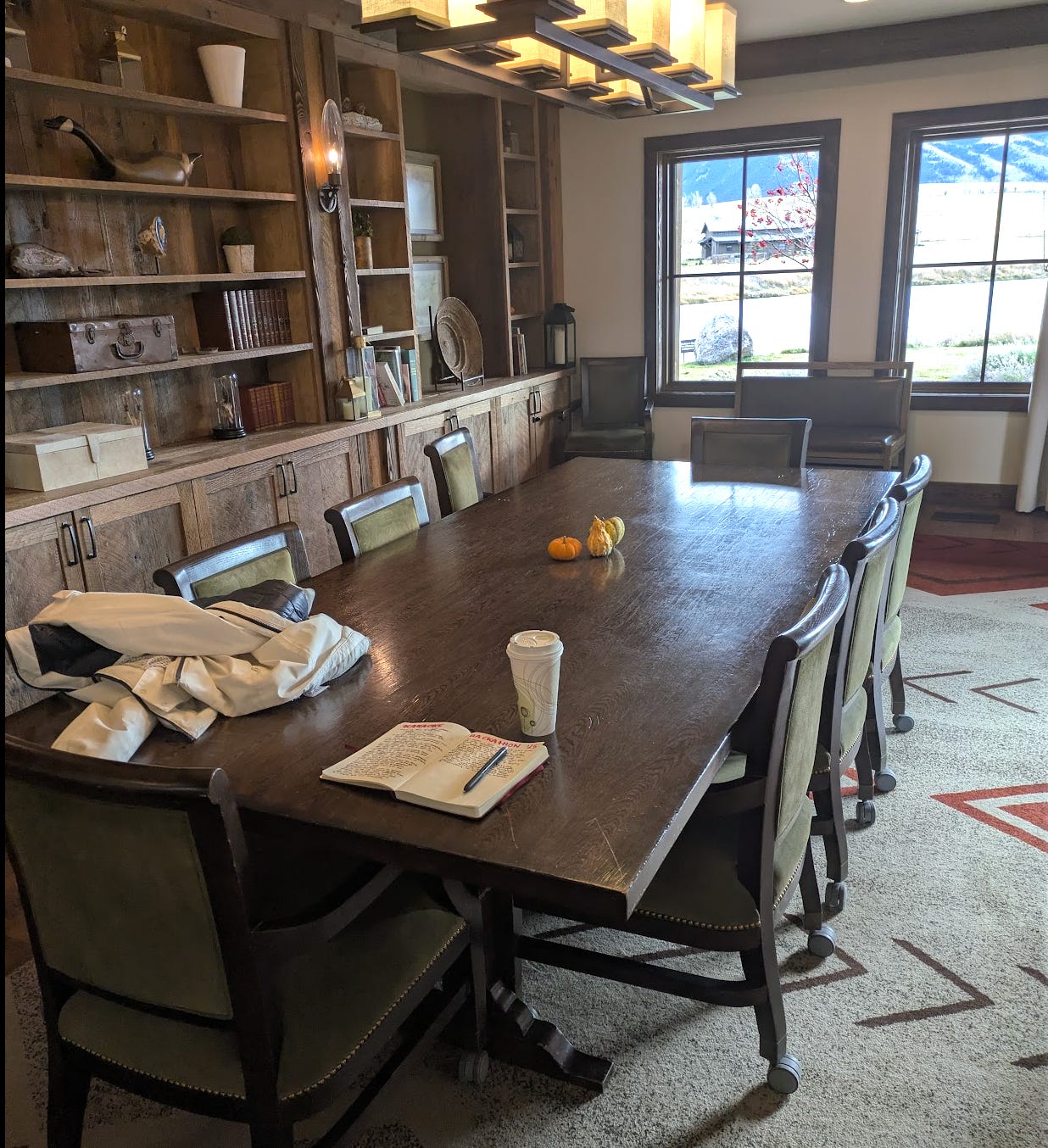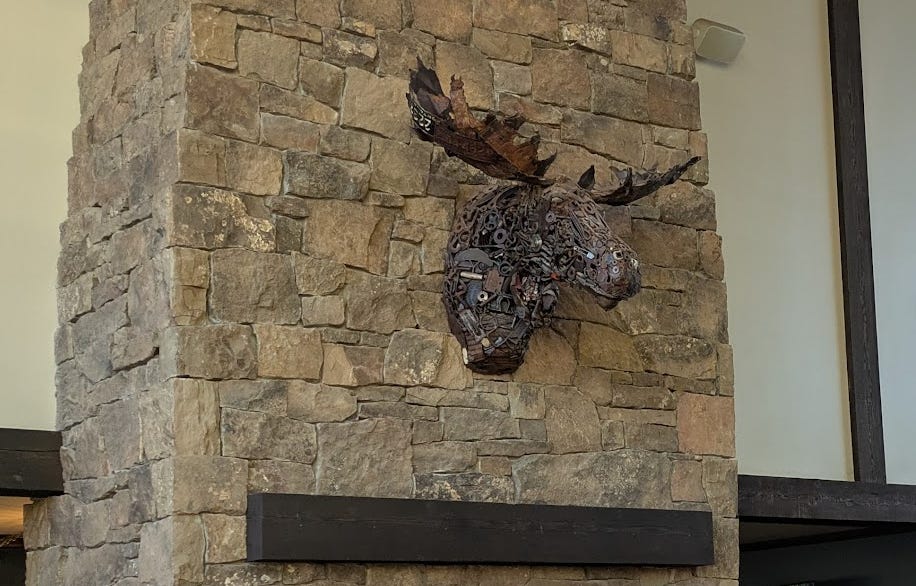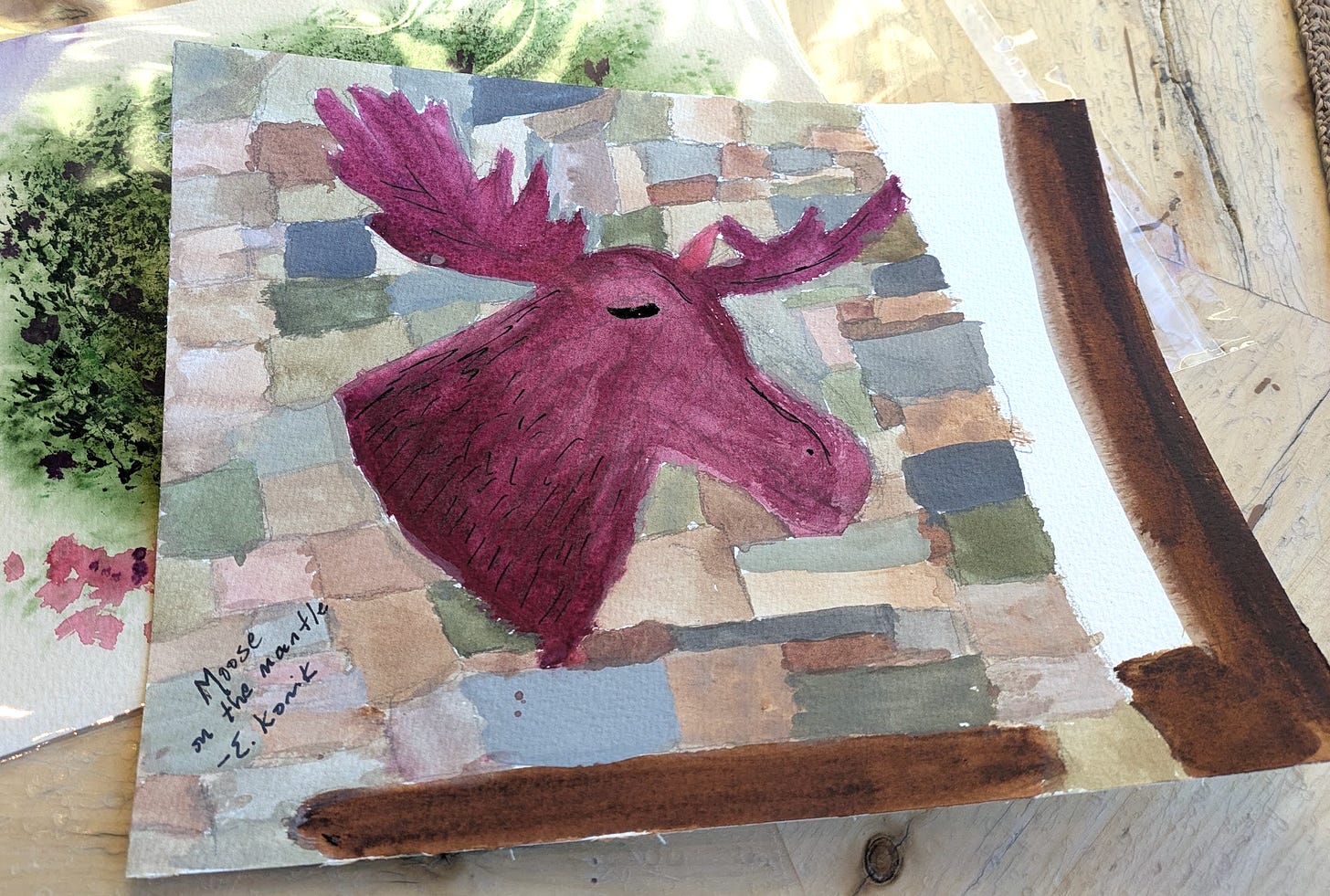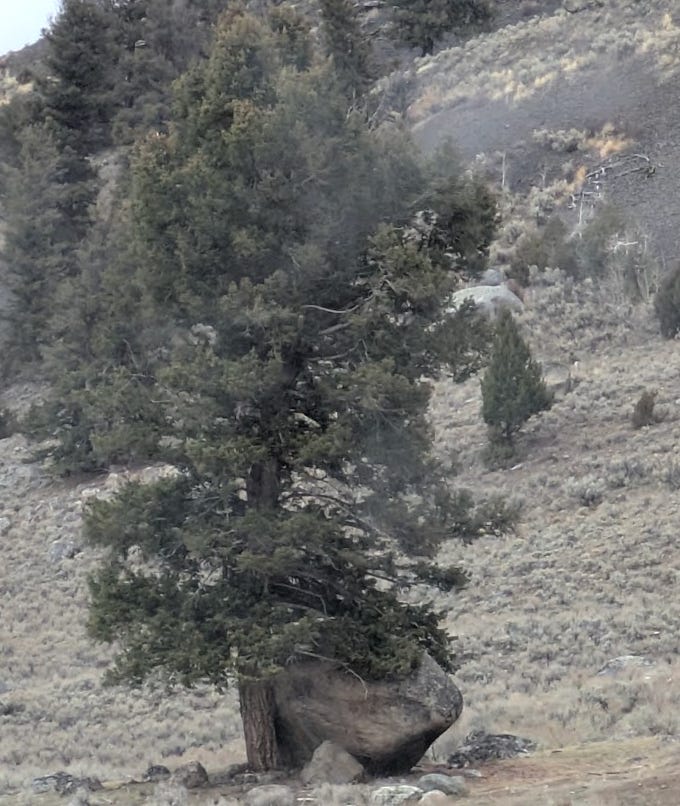🌲 Go Rogue. Change Direction. Produce Better Work.
There's a time for obsessively working on a single thing. Painting Montana is perhaps not that time.
This is not the article I intended to write today, and that’s kind of the point.
I’m in Montana this week for work, and had the opportunity to take a group watercolor painting class with some colleagues. I am not a particularly talented artist (as you may remember from my article about how I trace AI sketches when illustrating my notebook) and generally prefer oil and ink as artistic mediums, but I do like my coworkers and try to be open to trying new things.
Beforehand, I took some time to empty my brain of all the things floating around it. I added some notes about the animals I’d seen visiting Yellowstone opposite my original packing list, and on separate pages reflected on some of the technical projects we worked on (secret, sorry!) and things I learned about my coworkers that I don’t want to forget, like who has kids or has a specific diet. I also wrote down all the songs I sang during a 2am karaoke session, my favorite of which was Chicks Dig It by Chris Cagle because when one is in Montana, there should be at least a little bit of country music.
I mention this not because I think most readers particularly care that I know all the words to every song on the Horrorscope album by Eve 6 but because ‘journaling’ in the classic sense (“dear journal here’s how today went…) is something I do relatively rarely. I much prefer to make lists, write things down I don’t want to forget, or free-associate about a topic to brainstorm.
But so much has happened this week, and I learned so much, that I felt compelled to find a quiet corner and fill up several pages of my notebook.
While I was writing, I admired the little tree outside the window of the little library I was hiding away in, which was utterly bare of leaves but practically dripping with big red berry clusters. A woman wandered into the library and we chatted a bit; a Montana native, she let me know it was a mountain ash that I was admiring. I wrote it down, happy with how nicely my thoughts filled the page and the pink headers offset the black capitals of my slow-made notes.
A little later, the class began. I took my seat in front of an easel, beside a table with a palette and two mason jars: one with brushes, and one of water with a rock in it (why? I forgot to ask). We got a short lecture about how watercolor paint fresh from the tube is too bold to create the signature pastels of the medium, so we should activate the paint with water. We were given a graphite pencil and a fountain pen1 but warned that they don’t work well with watercolor, which isn’t opaque — so the pencil lines shine through.
For my first attempt at a painting, I played it straight. I attempted to capture the pond and the mountains and the golden autumn grass. I took the opportunity to draw the mountain ash, and immediately re-discovered that I don’t like washed out pastels nearly as much as I like thick, bold red textures like what I did with the berries. There’s something kind of weird about making spiky little dots with a thick watercolor sludge, but sometimes following directions is vitally necessary to completing a task well, and, whelp.
Sometimes it isn’t.
It’s not a particularly beautiful painting — especially compared to what my coworkers created — but I value it as a memento, not of the mountain views generally but because of the aspen.
Some “paint and sip” events have everyone paint the same thing with step-by-step directions from the teacher, and you only get to paint one thing. Here, we were allowed to paint as much as we could manage in two hours, so once I had something I didn’t entirely hate, I moved on.
I figured that the only way I was going to get any better as a watercolor artist was to iterate. Try lots of things. If I had just stayed on that landscape, fiddling and adding details, I would have messed up whatever beauty I’d managed to capture.
I tried something super close in, from memory — a bush with purple flowers, like the one I’d seen out front in the lodge’s garden. But I screwed up the perspective because I didn’t have a reference in front of me, and it somehow felt wrong to pull out my phone and try to paint from a photo.
I could do that anywhere, yanno? I don’t need to be in Montana to draw something on my phone, and if I’m gonna go that route I’d rather use the iPad (which I left at home) and trace.
I tried agian.
The artist had provided pencils, but warned that since watercolor is not opaque, any pencil work would be visible… so in my heart, I wanted to try the graphite pencil I was given, because it was a big, chonky, really neat one. It’s the only reason I was up for a third painting.
But everything I could see through the window I had already tried to paint, and the aspen was the only thing I really liked. I didn’t want to paint the aspen again, I didn’t want to make another run at the finicky mountain shadows, and I definitely did not want to try to paint chairs around a fireplace in watercolor.
So I swapped perspectives. Turned the chair around and looked inside the hotel. Saw this cool junk-metal moose that I would have loved to capture in ink but it was watercolor day and realistically I don’t have the skill to sketch from just looking — not least because I’m one of those poor bastards with aphantasia.. which makes it hard to remember what I just looked at if I start looking at a piece of paper instead.
It’s a small thing, but I’m proud of that decision — not because I did a particularly good job with the moose or the fireplace or mixing colors… but because I am an interior design nerd2 and although the mountains were very pretty, I can find beautiful landscape photographs of Montana mountains anywhere online. The big ones in person even do a pretty good job of capturing the scope and grandeur of the horizon.
Actually being inside, looking at the detail work of how the mantle matches the beams supporting the structure, really analyzing how the huge fireplace stones fit together? Watching a group of old guys happily having lunch with their wives and friends at the restaurant? Admiring the clever games decorating every table? Seeing how the map paintings were tidily matted?
I think I got more out of that than the stuff I was supposed to admire.
When I was in Yellowstone, people were mostly excited about the animals. We saw bears and coyotes and pronghorn and bison and so much elk, but my phone camera and five minutes per stop cannot possibly compare to the pros who get those perfect National Geographic shots, and most bison and elk look like every other bison and elk.
But the weird gaps around the stones I saw? The wavy pattern in the (bison?) scat I found? The trees nestled beside a boulder? It’s possible nobody has ever taken a photo like these, because normal people don’t care as much about that part of nature the way I do. Those photos feel special in a way that my photo of a bear was really just a note-to-self, a reminder that I should write down what I remember of the experience because the photo doesn’t capture it.
This photo is one of my favorites because it requires context to appreciate; it looks like the boulder rolled down the hill and stopped when it hit the tree, but that’s not what actually happened. The boulder was actually deposited here thousands (millions?) of years ago by a glacier. Its shadow created a microbiome, sort of like how the plants in Dune were watered by the dew collected by small plastic eggs. And so the tree prospered in soil that would not otherwise be able to support one.
So much of life is finding the one spot that’s a perfect fit for you to flourish. It’s about choosing the right perspective. Choose carefully, and don’t be afraid to change it when you don’t like the view that’s been laid out for you.
The place I was staying at had a hot tub, but it was fenced and obscured by big boulders. I could have chosen to be disappointed, but honestly — it was a great hot tub, maybe the only one I’ve ever been able to actually swim in.
Perfection is rare. Don’t let people tell you what we should care about; our unique joy comes from the bit that resonates personally. The trick is finding pleasure in the good parts, joy in the gaps that another person might not value. The common path is valuable, but there’s something to love about everything you do.
On a previous trip, I spent two days in Santa Fe with an explosive stomach bug. My daughter was only a few months old at the time, and my husband and son were back home. You’d think there isn’t much to appreciate about being trapped in your room, sick and miserable, missing dinner...
...but honestly even now, years later, I look back on that moment and feel not disappointment but rather a rush of gratitude for the heroic housekeeping staff that brought me grapes and helped clean up my puke.
The whole “when life gives you lemons, make lemonade” thing is a cliché, but honestly? In my family, we tend to eat the lemons whole, sometimes with chicken and sometimes on their own. The almost total elimination of scurvy is a modern miracle, and when life gives us lemons, we should celebrate.
Even if we’re godawful at still life paintings :P
Incidentally, I had a really fun moment of vindication: the fountain pens she provided were pilot varsity disposables, which is also my preferred fountain pen. We agreed that while it’s unfortunate they are not reusable (which means you can’t add your own specialty inks), the nibs are the perfect medium weight, not scratchy, and free-flowing. You can get a twelve pack (affiliate link) for the price of one Safari Lamy. I have fond memories of giving them out to students as rewards for interest and excellence back when I was teaching; my students found genuine fountain pens fascinating, and the disposables don’t take much maintenance or knowledge to get started with.
My favorite interior design book is Mountain House: Studies in Elevated Design by Nina Freudenberger, which has a wonderful diversity of photos and stories and doesn’t get too preachy. My kids loved snuggling on the couch with me while I read the descriptions out loud.





"I mention this not because I think most readers particularly care that I know all the words to every song on the Horrorscope album by Eve 6"
MILLENNIAL ROCK MENTIONED!!!!
Sorry but this was, in fact, the most interesting part of the post, for me!
I hope you signed your masterpieces. Someday and original Elenor Konik will be worth a LOT of Money :):):)